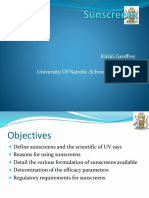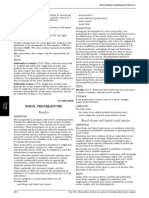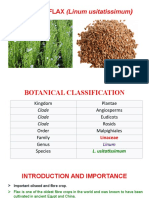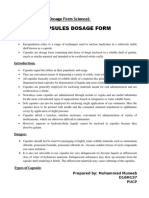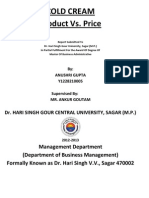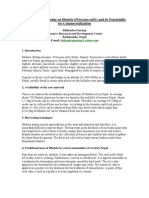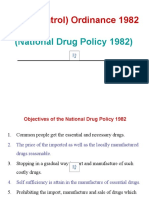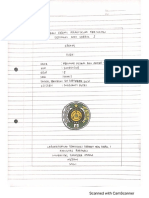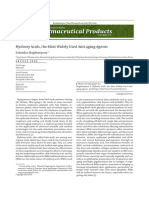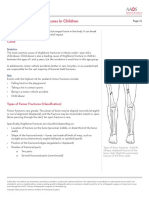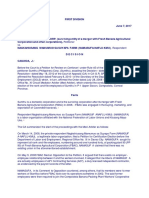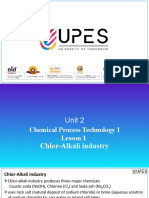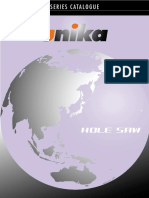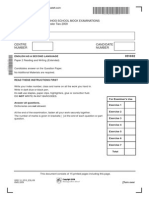Professional Documents
Culture Documents
Pharmaceutical Preparation and Evaluation of Cold Cream
Copyright
Available Formats
Share this document
Did you find this document useful?
Is this content inappropriate?
Report this DocumentCopyright:
Available Formats
Pharmaceutical Preparation and Evaluation of Cold Cream
Copyright:
Available Formats
Volume 8, Issue 5, May – 2023 International Journal of Innovative Science and Research Technology
ISSN No:-2456-2165
Pharmaceutical Preparation and
Evaluation of Cold Cream
Roshan Yadav*
Shiva Kant Thakur
Rishabh Parihar
Uma Chauhan, Arsh Chanana
Himmat Singh Chawra
Department of Pharmaceutics, NIMS Institute of Pharmacy, NIMS University, Jaipur, Rajasthan India
Abstract:- Since the beginning of time, creams have been beautification of skin. Cold cream is the water in oil
valued as essential topical preparations in cosmetic emulsion. Cold cream gives the prolonged contact time in
products because of how simple it is to apply and remove the site of application as compared to the other semisolid
them from the skin. Pharmaceutical creams are used for dosage form or formulation.
a number of aesthetic purposes, including cleansing,
beautifying, modifying look, moisturising, etc. They also They give elegancy to the skin and it is not that much
protect the skin from bacterial and fungal infections and greasy. Due to the oil phase, it gives an emollience to the
can be used to treat skin injuries including burns, cuts, skin. The function of the cold cream is for restoring
and wounds. The general population and society can moisture to dry skin, it allows to eliminate the waste
safely employ these semi-solid preparations. The materials from the pores and also cools the body. It is easily
products used to enhance and beautify human watered washable and easy to wash away. They are non-
appearances are known as herbal cosmetics. The current irritating when applied on the skin. The water phase
study's objective was to design and assess herbal cold provides the skin with additional protection. At body
creams that contained plant extracts made utilising the temperature, it becomes liquefiable. It enters the skin
water in oil method for the goal of moisturising and through the pores of the skin's epidermis.Galen, a Greek
nourishing the skin.Neem oil and turmeric extract are physician who created the cold cream formulation in the
used to make the cold cream. Utilising several evaluation second century, is credited with developing it. He made a
techniques, the created product’s quality was evaluated. mixture of water, beeswax, and rose petals. These were the
The physical characteristics of the cream formulation main moisturiser components he used to create the cold
did not alter. During the research study period, the cream. Galen's cream was the common name for this skin
cream formulation demonstrated good consistency and lotion. Cold creams can be used to remove temporary tattoo
spreadability, homogeneity, pH, non-greasy properties, marks and then removed with a cotton ball in addition to
and no signs of phase separation. There was no moisturising the skin. Uses of cold creams are also related to
discernible change in the created cream’s viscosity, the creation of children's face paint.[1]
aroma, or visual appearance during the research period,
according to stability measures. As the water in the II. TOPICAL DRUG DELIVERY
emulsion slowly evaporates, the cooling and calming
effects of the herbal extract with cold cream are The administration of medications to the human body
produced. Cold creams are more moisturising because through a variety of routes, including oral, sublingual, rectal,
they create an oily barrier to stop the loss of water from parental, topical, inhalation, etc., has been used to treat
the stratum corneum, the outermost layer of the skin. illnesses during the past few decades. Topical delivery is
They are water-in-oil emulsion and intended for the application of a drug-containing formulation to the skin
application on skin or accessible mucous membrane to to treat a cutaneous disorder or the cutaneous manifestations
provide localized and sometimes systemic effect at the of a general disease (such as psoriasis) directly with the goal
site of application. of containing the pharmacological or the effect of the drug
to the surface of the skin or within the skin. Semisolid
Keywords:- Beeswax, Parrafin. formulations in all their variety dominate the system for
topical delivery, but foams, spray, medicated lotions, and
I. INTRODUCTION other forms of topical administration are also used.[1, 2]
Cosmetics are the products which are generally used to
beautify the skin and also to purify the skin. The cosmetics
are the word derived from Greek word – ‘kosmesticos’
which means to adorn. From that time the materials which
are used to promoting appearances or to beautify the skin
are called as cosmetic. From ancient time till now people are
still using polyherbal or herbal cosmetics for the
IJISRT23MAY1437 www.ijisrt.com 1069
Volume 8, Issue 5, May – 2023 International Journal of Innovative Science and Research Technology
ISSN No:-2456-2165
III. ADVANTAGE OF TOPICAL DRUG Dermis:
DELIVERY The dermis is elastic and resilient. It is made of
connective tissue, and the matrix contains elastic and
Preventing of first pass metabolism. collagen fibres woven together. Stretch marks, also known
Convenient and simple to use. as permanent striae, are a result of the skin's elastic fibres
Prevention of risk. rupturing when it is overstretched during pregnancy and
The drawbacks of intravenous therapy and the various obesity. Water is held together by collagen fibres, which
conditions of absorption, such as PH changes, the also give the skin its tensile strength. As collagen fibres age,
presence of enzymes, the rate at which the stomach wrinkles start to appear. The primary cells in the dermis are
empties, etc mast cells, macrophages, and fibroblasts. Areolar tissue and
Continuous drug input can achieve efficacy with a various levels of adipose (fat) tissue are found under the
lower total daily dose of medication skin's lowest layer.
Prevent intra- and inter-patent fluctuations in
medication levels Subcutaneous Gland:
Another crucial location for the processing and
The medicine or its excipients may cause skin irritation
or dermatitis regulation of androgen is the sebaceous gland. The skin
contains all the required enzymes for converting cholesterol
Because they are poorly fat soluble and have a large
to steroid precursors or adrenal hormones, such as
molecular weight, most medications are not absorbed
dehydroepiandrosterone. Using an enzyme that is present as
through the skin or mucous membranes.
early as 16 weeks of foetal life, hydroxysteroid
Very low absorption. dehydrogenase, the sebaceous gland can also inactivate
It can only be used for medications whose plasma androgens. In the sebaceous glands, particularly those on the
concentrations must be extremely low to work. face and scalp, the type-1 isoform of 5-alpha-reductase,
May only be used for medications whose action which is responsible for converting testosterone into its most
depends on very low plasma concentrations. potent form, is also abundantly generated. Hormones play a
The potential for allergic responses. significant role in controlling the sebaceous gland. By
Larger-particle drugs are more difficult to absorb via attaching to nuclear androgen receptors (AR), androgens
the skin.[3] control the activity of the sebaceous gland. Numerous skin
components include ARs, with the sebaceous gland—where
IV. PHYSIOLOGY OF HUMAN SKIN androgens are found—having a special affinity.[4]
Epidermis: V. FUNCTIONS OF SKIN
The thickness of the stratified, keratinized squamous
epithelium that makes up the epidermis, the skin’s outermost Skin Performs the following Functions:
layer, varies depending on where on the body it is located.
The palms of the hands and the bottoms of the feet have the Langerhans cells: which are a component of the
thickest layer. There is no blood present. The dermis’ adaptive immune system, are an anatomical barrier that
interstitial fluid, which supplies oxygen and nutrients and protects the body from pathogens and damage between
drains away as lymph, bathes the deeper layers of the the internal and exterior environments.
epidermis but does not reach the veins or nerve terminals of Sensation: Consists of a range of nerve endings that
the epidermis. respond to touch, pressure, vibration, and tissue injury.
For more information, see the somatosensory system
and haptics
Heat regulation: The skin's blood supply is far more
than what it needs, allowing for fine control of energy
loss by radiation, convection, and conduction.
Constricted blood vessels significantly restrict
cutaneous blood flow and maintain body heat whereas
dilated blood vessels promote perfusion and heat loss.
Controlling evaporation: The skin acts as a semi-
permeable, relatively dry barrier against fluid loss. The
significant fluid loss in burns is a result of the loss of
this function.
Others can judge our emotions, physical condition, and
beauty based on the appearance of our skin.
Storage and synthesis: By the action of UV rays on
specific areas of the skin, it serves as a storage site for
lipids and water as well as a method for vitamin D
production.
Fig 1 Structure of Skin
IJISRT23MAY1437 www.ijisrt.com 1070
Volume 8, Issue 5, May – 2023 International Journal of Innovative Science and Research Technology
ISSN No:-2456-2165
Water resistance: The skin serves as a water-resistant its name from the fact that it feels cold to the touch. People
barrier to prevent the body’s vital nutrients from being use it to soften their skin, calm sunburns, and protect their
rinsed away. [5] faces from cold weather, among other things. The
combination of fats and water in this product helps
Diseases of Skin moisturise. Unlike the “oil in water” type emulsion of
vanishing cream, which is so-called because it appears to
Vitiligo. vanish when applied to skin, the emulsion is of the “water in
Scabies. oil” kind. An example of a cold cream is a lubricating
Rosacea. cream, often known as a night cream or massage cream,
Psoriasis. which contains lanolin and its derivatives.
Melanoma.
The term "cold cream” refers to the numbing sensation
Eczema.
the cream left behind on the skin. Water in oil (w/o)
Cold Creams: emulsions were typically used to create cold creams. Much
of the water in the creams evaporates after they are applied
to the skin, leaving the residual oil to function as a solvent,
Cold cream is an emulsion of water and certain fats that
clearing the skin of makeup and other impurities.
is used to smooth skin and remove makeup. It typically
Additionally, surfactant activity might exist. According to
contains beeswax and other fragrances.
some chemists, the cooling effect of the water evaporation
The European Pharmacopoeia refers to it as Fatty
on the skin is the reason why these creams are referred to as
Cream. “cold creams.”An other argument Is that the creams required
Water and oil are combined in every type of cold to be stored in a cool environment to prevent them from
cream. The water in the cream evaporates as you apply growing rancid in the days before mineral oil or Petrolatum
it to your skin, giving you a cooling sensation. Most were utilised. They acquired their moniker because of how
likely, the name came from this chilling effect. frigid they felt to the touch. Galen, a Roman physician who
Moisturiser or moisturising cream are other names for lived around 150 CE, is credited with creating the first cold
cold cream. Cold cream needs to behave emolliently. cream by blending water with molten beeswax and olive oil.
When used, it should feel cool to the touch and leave no It took a lot of mixing to make it, and when it stood, it
occlusive oil film on the skin. tended to split. The recipe, which typically uses rosewater
Although it is an emulsion with a high proportion of and/or oil of roses as a perfume, continued nonetheless, and
fatty and oily content, it has a cooling effect when was included in the first edition of the “pharmacopoeia
applied to the skin because the water in the emulsion Londinensis” in 1618.
slowly evaporates. An illustration of a water-in-oil
(W/O) emulsion is cold cream Early versions were not durable because vegetable
In cold cream, the major portion is the oil phase. oils, including almond oil, are susceptible to deterioration
Simply, the cold cream is an oil-based semisolid when combined with water. Cold creams were typically
preparation. Cold cream is also known as Unguentum prepared at home or bought in small quantities freshly
or Ceratum Refrigerans. Generally, it contains mineral prepared by a neighbourhood pharmacy, chemist or druggist
oil, beeswax, borax, and water . because of their limited shelf life.
It is a cosmetic that calms and cleanses the skin; it often
has an oily and heavy consistency. It fits the description Cold creams with a high concentration of mineral oil
of a cleansing cream. [6] (liquid paraffin) or petroleum jelly were generally used as
cleansers, applied thickly, and then removed with a cloth or
VI. HISTORY OF COLD CREAM tissues. They were frequently marketed as beauty creams or
PREPARATION night creams, although depending on the formulation, they
might be used for a range of things.[7, 4]
Prior to the first century, numerous druggists would
prepare rosewater cream and keep it chilled on ice so that it VII. GENERAL INGREDIENTS USED IN COLD
would be suitable for use as a skin cream. Since the water in CREAM
cold cream evaporates when applied, it produces a cooling
sensation, thus the Latin word “refrigeran” (meaning Table 1 Ingredients Used In Cold Cream
“making cold”). Ingredients Quantity Use of
taken(20gm) ingredients
Galen, a renowned Greek physician and chemist who Bees wax 3.2gm Emulsifying
worked in Rome during the First Century AD’s Roman agent
Empire, is credited with creating the first cold cream. Over Borax 0.16gm Emollient
many centuries, the proportions and preparation procedure Methyl paraben 0.02gm Preservative
of the Galen cold cream formula have seldom changed. Liquid paraffin 10ml Laxative
Water 6ml Diluent
It is ideal for treating dry skin on the knees, feet, and
Perfume 0.62ml Fragrance
elbows as well as for using as a natural makeup remover and
preventing eczema in dry areas of the body. The cream gets
IJISRT23MAY1437 www.ijisrt.com 1071
Volume 8, Issue 5, May – 2023 International Journal of Innovative Science and Research Technology
ISSN No:-2456-2165
Apparatus Used: The china disc was taken out of the water bath and set
aside.
Measuring cylinder We should keep in mind that the temperature of the
Spatula combined solution should be up to 70°C and that it
Pipette should be in a liquid state before adding the remaining
Water bath ingredients to it.
China disc Next, using a glass rod to stir, we combined the borax
Glass rod and water.
Thermometer To get borax to dissolve in water, we boil the mixture in
a water bath until it does.We dropped the boric acid
Raw Materials Used: solution into the first solution after the borax had
Mineral and vegetable oils, together with fatty completely dissolved.
alcohols, fatty acids, and fatty esters, emulsifying agents, Dropwise add the boric acid solution while stirring the
preservatives, and filtered water, can all be used to create mixture continually with a glass rod.
cold creams. There should be the following four main The following stage was adding the previously weighed
components: 0.02 gm of methyl paraffin and mixing the solution with
a glass rod until all of the paraffin’s particles were fully
Oil dissolved.
Water As a final touch, we added a drop or two of rose oil,
Emulsifier which we utilised to smell the recipe.
Thickening Agent After that, we continually stirred the entire mixture
using a glass rod until it took on a semi-solid form.
Procedure of Making Cold Cream:
To start, we weighed each ingredient.
Next, we add the 3.2 grammes of weighed beeswax to
the china disc, which serves as the basis in this case.
The 10ml of liquid paraffin is then added to the china
disc.
Fig 4 Prepared Cold Cream
Lastly we got our Final Product (cold cream).
VIII. USES OF COLD CREAM
Fig 2 Bees Wax The contents of a cream determine the uses of cold
cream, i.e., functional ingredients determine the uses of cold
After melting the beeswax and making it miscible with cream. These are the primary applications for cold cream: In
the liquid paraffin, we combined the two materials order to maintain the skin’s moisture balance and prevent
using a glass rod and heated the mixture in a water bath dry skin diseases, medicated cold cream is primarily utilised
at 70°C. as a topical pharmaceutical dosage form for the treatment of
skin. It is one of the basic applications for non-medicated
cold cream.
As a makeup removal and cleansing preparation.
In order to provide an emollient effect
To give the skin an oiled barrier of protection.
As with sunscreen components, additionally offer a
chemical barrier.
As a vehicle for pharmaceutical ingredients such
diflucortolone valerate in ointments.
To eliminate skin contaminants that are soluble in oil
Fig 3 Hot Water Bath
IJISRT23MAY1437 www.ijisrt.com 1072
Volume 8, Issue 5, May – 2023 International Journal of Innovative Science and Research Technology
ISSN No:-2456-2165
IX. FUNCTIONS AND USES OF THE Borax:
INGREDIENTS USED IN THE
PREPARATION The main component of borax is boric acid salt. This
serves as an emulsifying agent by reacting with the
Bees Wax: beeswax’s free acids.
A chemical called an emulsifying agent makes water
It functions as an antioxidant. Beeswax is frequently and other substances miscible.
included in the development of skin moisturisers and Borax keeps the preparation’s ph stable and inhibits
body creams since it supports moisturising and bacterial development.
softening as well as encourages cell repair, making it a It is known as sodium tetra borate in scientific jargon,
fantastic ingredient to employ when creating products and it is a mixture that is combined from the depths of
specifically for dry and rough skin types the earth and also found as deposits in lake bottoms and
Beeswax serves as an emollient (skin softening) and mountain runoffs.
humectant (attracts water and aids in absorbing it in the Wax and borax are both common ingredients in creams,
skin) in this form of body care. gels, and lotions for cosmetic usage.
which works here as a stiffning agent , which increases Borax’s alkaline nature makes it the ideal ingredient in
the viscosity cold cream beside this, beeswax also cleaner products, where it is famously used to help
shows healing property and this is a good source of vit. wash off the oil or grease from the hands.
A .It is a common ingredient of most of the cosmetic However, some of these properties might irritate the
products skin and lead to rashes
Like – skin moisturizer, body creams, lip glose, lip Boric acid and sodium borate both inhibit or stop
balm, eye shadow, lipstick. bacterial development, preventing spoiling of cosmetics
Beeswax also as medicinal benefits to its use in body and personal care items.
products as well .
Beeswax as anti inflammatory, antiviral, and Methyl Paraben:
antibacterial properties. These 3 properties make
beeswax very helpful for the healing of shaller wounds In this circumstance, the methyl paraben functions as a
and injuries and can also be used for slight skin preservative to stop the growth of dangerous
irritations too. microorganisms.
Beeswax also has therapeutic properties and is a strong Methyl paraben is a form of paraben. Parabens are
source of vitamin A, and it acts here as a stiffening chemicals that are frequently employed as preservatives
agent, increasing the viscosity of the cold cream. to extend the shelf life of items.
The majority of cosmetic goods often contain it as an In order to stop the growth of mould and other
ingredient. dangerous bacteria, they are added to food or cosmetics.
For example, lip gloss, lip balm, eye shadow, lipstick, Many products that contain methyl paraben also contain
body creams, and moisturisers for the skin. one or two other types of parabens in their ingredients.
The usage of beeswax in cosmetic and personal care Foods, medications, and a wide range of cosmetic
products has health benefits. products all contain parabens.
Parabens may be present in a variety of cosmetics,
Liquid Paraffin: including makeup, moisturiser, hair care, and shaving
products.[8]
Liquid paraffin, a mineral oil that is essential for skin
care since it keeps the skin moisturised. X. COLD CREAM FOR COLD
It serves as a barrier to the skin, preventing moisture WEATHER
loss.
Liquid paraffin is also used in the cosmetics business. For good reason—its hydrating benefits—cold cream
The ingredient can be found in a variety of beauty has had a modern renaissance. Dry skin is a result of the
products, such as detergent creams, cold creams, cold weather, and cold creams are fantastic for dry skin.
moistened creams, oils, and cosmetics. As an emollient
lotion, it can be used to treat dry skin Water and oil are emulsified to create cold cream. The
To aid in the skin’s ability to retain moisture, liquid difference between water and oil is significant to the
paraffin is frequently used in cream formulations for formulation of the cold cream recipe since it causes the skin
skin care. to feel cold when applied, hence the name. This is due to the
The skin has a built-in barrier that protects against fact that cold cream absorbs more slowly into the skin than
moisture loss and keeps the skin healthy. oil in water products do. The four main components of cold
Skin disease symptoms may be lessened with liquid cream are typically water, oil, an emulsifier, and a
paraffin. thickening agent.
The cream can reach the outer layer of skin without
being absorbed as deeply Into your skin as water-based
treatments because water and oil are mixed in roughly equal
IJISRT23MAY1437 www.ijisrt.com 1073
Volume 8, Issue 5, May – 2023 International Journal of Innovative Science and Research Technology
ISSN No:-2456-2165
amounts. As a result, when used as a nocturnal skin XII. RESULT
treatment, it feels more like an overnight mask than a
moisturiser.[9] Morphological Evaluation:
A morphological evaluation of cold cream is shown in
Ideal Characteristics of Cold Cream the Table. Formulation was a white. The produced
formulations’ pleasant and well-acceptable flavour makes
Normally, it shouldn’t be diluted. them ideal for cosmetic formulations. Smoothness and
The cold cream’s pH should ideally range from 4.6 to texture was suitable for cosmetic formulation requirements.
6.0.
It should have the ideal consistency to allow for easy Table 2 Data of Morphological Evaluation
application and removal from the container. Morphological parameter Results
Following external application, the skin should Color White
experience a cooling effect. Odour Pleasant
To prevent water from evaporating from the skin’s Texture Fine
surface, it must create a thin, waxy protective coating
on the skin. pH : The pH is found to be neutral and shown in table
Should have a quicker emollient action so that as
extremely dry skin can quickly expand and soften.
Ointments tend to be more oily. Table 3 pH Test
Creams often have a white to off-white colour, although pH 7.3
they can also have other colours, such yellow (Nystatin
Cream USP). Stability:
Easily applied to skin. The stability results were displayed in Table. No
Free of dusty components. change in colour, smell, texture, or smoothness was noticed
under the stability parameters stated. The stability research
XI. EVALUATION OF COLD CREAM indicated that at normal temperature.
The following several test may perform to evaluate the Table 4 Stability Testing
quality of cold cream. Stability parameter Result
Color No change
Morphological Evaluation: This refers to the manual Odour No change
evaluation of an ice cream’s physical characteristics Texture No change
based on its colour, flavour, and texture. pH No change
pH: In order to calibrate the pH metre, standard buffer
solution was used. With the aid of a digital pH metre, Irritancy Test:
weigh 0.5 g of cream and dissolve it in 50.0 ml of The table below displays the results of the irritancy
purified water. test. During irritancy trials, the formulation displayed
Test for Spreadability: The cream sample was placed in absence of irritation, redness, and edema. This formulation
between the two glass slides and compacted to a is skin safe for usage.
uniform thickness by applying weight for five minutes
before adding more weight to the weighing pan. The Table 5 Result of Irritancy Test
spreadability was measured by the amount of time the Irritancy test Result
upper glass slide travelled across the lower slide. Irritation No
Stability Test: A month-long stability test was Edema No
conducted on the developed formulation by storing it at Redness No
various temperatures. While being maintained at Swelling No
various temperatures, including room temperature and
40°c, the packed glass vials of formulation were Spreadability: The Spreadability of cold cream was
examined for physical traits such as colour, aroma, pH, shown in table and found to be
consistency, and feel.
To Test for Irritability, mark a 1-square-centimeter Table 6 Result of Spreadability Test
region on the left dorsal surface. The cream was applied Formula Average spreadbility
to the designated region, and the duration was recorded. FI 6.5
The presence of irritation was monitored for up to 24
hours at regular intervals. Homogenicity: The homogenicity of cold cream was
Homogeneity: The homogeneity was examined visually quite good enough.
and tested. [10]
IJISRT23MAY1437 www.ijisrt.com 1074
Volume 8, Issue 5, May – 2023 International Journal of Innovative Science and Research Technology
ISSN No:-2456-2165
XIII. CONCLUSION
The created cream demonstrated good consistency and
spreadability, homogeneity, pH, non-greasyness, and there
was no phase separation during the research period,
according to the aforementioned data. The purpose of cold
cream is to moisturise dry skin and cool the body while also
removing waste from pores and pores. It is simple to wet,
wash, and put away. When used on the skin, they do not
irritate. The skin receives additional conservation from the
water phase.
REFERENCES
[1]. Susan C. Wivell, Clear cold cream cosmetic
compositions, United States Patent. 1996.
[2]. Remington, Joseph P, and Paul Beringer. Remington:
The Science and Practice of Pharmacy. 21st edition.
Philadelphia: Lippincott Williams & Wilkins; 2005.
[3]. Poucher, W A, and George M. Howard. Perfumes,
Cosmetics, and Soaps. London: Chapman and Hall,
1974.
[4]. British Pharmacopoeia Commission. British
Pharmacopoeia 2021. London: TSO.
[5]. The United States pharmacopeia The National
formulary. Rockville, Md.: United States
Pharmacopeial Convention, Inc. (USP 21 – NF 16).
[6]. Lachman, Lieberman, H.A. and Kanig, J.L., The
Theory and Practice of Industrial Pharmacy, Lea and
Febiger, New York, 15th edition; 2013.
[7]. Prasanna A. Datar.(2013) Formulation and evaluation
of polyherbal gel prepare using Carbopol 934 for
treating skin disease in comparison with ointment
using emulsifying ointment, Research and Reviews:
Journal of Pharmaceutics and Nanotechnology, 1(1):
20-21.
[8]. Uddandu Saheb*, Aduri Prakash Reddy, K. Rajitha,
B. Sravani, B. Vanitha,(2018). Formulation and
Evaluation of Cream from containing plant extracts,
World Journal of Pharmacy and Pharmaceutical
Sciences, 7(5) :851-862.
[9]. R. Patel, H. U.Momin, R.L. Dhumal, K, L. Mohite,
(2017), Prepara preparation and evaluation of
multipurpose herbal cream , Adv Pharm Life sci
Res;5(1);27-32.
[10]. Jansen LH, Hojyo-Tomoko MT, Kligman AM.
Improved fluorescence staining technique for
estimating turnover of the human stratum corneum.
Br J Dermatol. 1974;90:9–12.
IJISRT23MAY1437 www.ijisrt.com 1075
You might also like
- Active Ingredients of CosmeceuticalsDocument6 pagesActive Ingredients of CosmeceuticalsRnD Roi SuryaNo ratings yet
- Herbal Cosmetics 1Document19 pagesHerbal Cosmetics 1Mas Nuri100% (1)
- SuppositoryDocument12 pagesSuppositoryKhushboo100% (2)
- FAO Fish Handbook Fish FarmingDocument89 pagesFAO Fish Handbook Fish FarmingLee kamunya100% (1)
- SunscreensDocument34 pagesSunscreensKabue KiriiriNo ratings yet
- Powders and Granules For Syrups: Nasal PreparationsDocument2 pagesPowders and Granules For Syrups: Nasal PreparationsAat Prayoga MuhtarNo ratings yet
- 1.JATIN .Formulation and Evaluation of Herbal Antia-Cne Face PackDocument21 pages1.JATIN .Formulation and Evaluation of Herbal Antia-Cne Face PackIshwarjit SinghNo ratings yet
- PT3 Practices EssayDocument61 pagesPT3 Practices EssayGolden Fingers100% (3)
- Bearberry - Liquid Herbal Extract (Cosmetic Grade) Msds Rd28!05!2013Document11 pagesBearberry - Liquid Herbal Extract (Cosmetic Grade) Msds Rd28!05!2013Meidita Aulia DanusNo ratings yet
- Zinc Oxide Topical PasteDocument33 pagesZinc Oxide Topical PasteEj RoblezaNo ratings yet
- Cosmetic Lecture-3Document8 pagesCosmetic Lecture-3Daddy RulesNo ratings yet
- MSC Nursing Approved Thesis Topics 2009-12Document32 pagesMSC Nursing Approved Thesis Topics 2009-12Anonymous 4L20Vx60% (5)
- Preparation and Evaluation of Herbal Cold Cream With Incorporated Curcuma LongaDocument3 pagesPreparation and Evaluation of Herbal Cold Cream With Incorporated Curcuma LongaInternational Journal of Innovative Science and Research TechnologyNo ratings yet
- Journal of GelDocument25 pagesJournal of GelRiskilla Fauziyanda PNo ratings yet
- Dosage FormDocument48 pagesDosage FormbenreuNo ratings yet
- Channel PPT HerbionDocument18 pagesChannel PPT HerbionMuhammad YameenNo ratings yet
- Creams and Ointments, What's The Difference, Which Is BestDocument3 pagesCreams and Ointments, What's The Difference, Which Is Bestchrizela20No ratings yet
- Unit 5 CosmeticsDocument14 pagesUnit 5 CosmeticsRevathiNo ratings yet
- LINSEED / FLAX (Linum UsitatissimumDocument35 pagesLINSEED / FLAX (Linum UsitatissimumAnshul SharmaNo ratings yet
- Formulation, Development and Evaluation of Herbal Antiaging CreamDocument6 pagesFormulation, Development and Evaluation of Herbal Antiaging CreamEditor IJTSRDNo ratings yet
- Indian Herbs for Diabetes: A Life Threatening DiseaseDocument1 pageIndian Herbs for Diabetes: A Life Threatening Diseasemanas chatterjeeNo ratings yet
- 07 Dermatological Formulation and Transdermal SystemsDocument81 pages07 Dermatological Formulation and Transdermal SystemsAlberto JacobusNo ratings yet
- Tablet, Granules, CapsulesDocument49 pagesTablet, Granules, CapsulesRubab Syed100% (1)
- Unit OintmentDocument39 pagesUnit OintmentEE KMNo ratings yet
- Nicotinamide - Mechanism of Action and Indications in DermatologyDocument4 pagesNicotinamide - Mechanism of Action and Indications in Dermatologyreni awNo ratings yet
- Biologics, Immunology and PharmacognosyDocument26 pagesBiologics, Immunology and PharmacognosyShereenNo ratings yet
- Industrial Visit Report InsightsDocument12 pagesIndustrial Visit Report InsightsArshNo ratings yet
- Cold Cream Comparative AnalysisDocument29 pagesCold Cream Comparative AnalysisSumit Verma100% (2)
- Methyl Salicylate OintmentDocument4 pagesMethyl Salicylate OintmentMichael TorresNo ratings yet
- CompanyDocument32 pagesCompanySobia MughalNo ratings yet
- Skincare guide covering external preparationsDocument20 pagesSkincare guide covering external preparationsShailendra SkNo ratings yet
- Single Emulsion-Solvent Evaporation Technique and Modifications For The Preparation of Pharmaceutical Polymeric NanoparticlesDocument15 pagesSingle Emulsion-Solvent Evaporation Technique and Modifications For The Preparation of Pharmaceutical Polymeric NanoparticlesChâu Trần Lê TuyếtNo ratings yet
- Traditional Knowledge On Dhatelo and Its Potentiality For CommercializationDocument2 pagesTraditional Knowledge On Dhatelo and Its Potentiality For Commercializationkhilendra gurung83% (6)
- Emulsions: (A) Dilution TestDocument5 pagesEmulsions: (A) Dilution TestEman AzizNo ratings yet
- Hospital Pharmacy Ward InspectionDocument4 pagesHospital Pharmacy Ward Inspectionamazing BoyNo ratings yet
- Soft Cap-2Document36 pagesSoft Cap-2DrSambathkumar RamanathanNo ratings yet
- Syrup and Elixirs - Presentation Muneeb (Secured)Document50 pagesSyrup and Elixirs - Presentation Muneeb (Secured)Rubab Syed100% (1)
- Week 9 - Drug (Control) Ordinance 1982Document10 pagesWeek 9 - Drug (Control) Ordinance 1982Runa akterNo ratings yet
- Powder: Mr. Suraj Mandal M.Pharm PharmaceuticsDocument37 pagesPowder: Mr. Suraj Mandal M.Pharm PharmaceuticsAshwani Guleria100% (1)
- OrganizedDocument72 pagesOrganizedmuslim thinkerNo ratings yet
- 2320-Article Text-8384-1-10-20231011Document12 pages2320-Article Text-8384-1-10-20231011anggawiryabonnieNo ratings yet
- 2 FormulationDocument10 pages2 FormulationNguyen HungNo ratings yet
- Formulation and Evaluation of Anti Aging Poly Herbal CreamDocument5 pagesFormulation and Evaluation of Anti Aging Poly Herbal Cream44omkar patharkarNo ratings yet
- Nil For Ou SH Zadeh 2018Document10 pagesNil For Ou SH Zadeh 2018Ricky SpideyNo ratings yet
- CREAMDocument7 pagesCREAMrajan mishraNo ratings yet
- WJPR506Document19 pagesWJPR506Afifah Dwi CahyaniNo ratings yet
- Implantable PreparationDocument63 pagesImplantable PreparationCamille WuNo ratings yet
- Formulation and Invitroevaluation of Poly Herbal Anti Aging Face CreamDocument17 pagesFormulation and Invitroevaluation of Poly Herbal Anti Aging Face CreamVaishali PathakNo ratings yet
- Project CreamDocument35 pagesProject Creamharsh mainiNo ratings yet
- Semisolid Dosage FormDocument77 pagesSemisolid Dosage FormMonyratanak LimNo ratings yet
- Liter VA 2Document17 pagesLiter VA 2Mannan ZubaidiNo ratings yet
- Pharmaceutical Creams and Their Use in Wound Healing: A ReviewDocument6 pagesPharmaceutical Creams and Their Use in Wound Healing: A ReviewSujit DasNo ratings yet
- Journal of Pharmaceutical and Biological Sciences: Skin Cream As Topical Drug Delivery System: A ReviewDocument6 pagesJournal of Pharmaceutical and Biological Sciences: Skin Cream As Topical Drug Delivery System: A ReviewDr-Md Abul BarkatNo ratings yet
- Development Team: Pharmaceutical Sciences Cosmetics Skin Care ProductsDocument26 pagesDevelopment Team: Pharmaceutical Sciences Cosmetics Skin Care Productschi nguyenNo ratings yet
- Cosmeceuticals For The Skin An OverviewDocument6 pagesCosmeceuticals For The Skin An Overviewmigaloooo334No ratings yet
- Cold CreamDocument9 pagesCold CreamArumm88No ratings yet
- Semisolid Dosage FormDocument12 pagesSemisolid Dosage Formdhananjay taumarNo ratings yet
- Semisolid Dosage Forms: Presented byDocument69 pagesSemisolid Dosage Forms: Presented byAhmad AinurofiqNo ratings yet
- 289 549 1 PBDocument8 pages289 549 1 PBantung lisa ariatiNo ratings yet
- JJNPP 07 09Document2 pagesJJNPP 07 09Bianca ChristabelNo ratings yet
- Dermatopharmatology: Aldilanoviatri Timpengajarfarmakoterapi Fkhub 2 0 1 8Document64 pagesDermatopharmatology: Aldilanoviatri Timpengajarfarmakoterapi Fkhub 2 0 1 8Nadiya ShiyamahNo ratings yet
- Understanding Moisturizers and Their Clinical BenefitsDocument4 pagesUnderstanding Moisturizers and Their Clinical BenefitsTaniaNo ratings yet
- PressedDocument4 pagesPressedMas NuriNo ratings yet
- Cyber Security Awareness and Educational Outcomes of Grade 4 LearnersDocument33 pagesCyber Security Awareness and Educational Outcomes of Grade 4 LearnersInternational Journal of Innovative Science and Research TechnologyNo ratings yet
- Factors Influencing the Use of Improved Maize Seed and Participation in the Seed Demonstration Program by Smallholder Farmers in Kwali Area Council Abuja, NigeriaDocument6 pagesFactors Influencing the Use of Improved Maize Seed and Participation in the Seed Demonstration Program by Smallholder Farmers in Kwali Area Council Abuja, NigeriaInternational Journal of Innovative Science and Research TechnologyNo ratings yet
- Parastomal Hernia: A Case Report, Repaired by Modified Laparascopic Sugarbaker TechniqueDocument2 pagesParastomal Hernia: A Case Report, Repaired by Modified Laparascopic Sugarbaker TechniqueInternational Journal of Innovative Science and Research TechnologyNo ratings yet
- Smart Health Care SystemDocument8 pagesSmart Health Care SystemInternational Journal of Innovative Science and Research TechnologyNo ratings yet
- Blockchain based Decentralized ApplicationDocument7 pagesBlockchain based Decentralized ApplicationInternational Journal of Innovative Science and Research TechnologyNo ratings yet
- Unmasking Phishing Threats through Cutting-Edge Machine LearningDocument8 pagesUnmasking Phishing Threats through Cutting-Edge Machine LearningInternational Journal of Innovative Science and Research TechnologyNo ratings yet
- Study Assessing Viability of Installing 20kw Solar Power for the Electrical & Electronic Engineering Department Rufus Giwa Polytechnic OwoDocument6 pagesStudy Assessing Viability of Installing 20kw Solar Power for the Electrical & Electronic Engineering Department Rufus Giwa Polytechnic OwoInternational Journal of Innovative Science and Research TechnologyNo ratings yet
- An Industry that Capitalizes off of Women’s Insecurities?Document8 pagesAn Industry that Capitalizes off of Women’s Insecurities?International Journal of Innovative Science and Research TechnologyNo ratings yet
- Visual Water: An Integration of App and Web to Understand Chemical ElementsDocument5 pagesVisual Water: An Integration of App and Web to Understand Chemical ElementsInternational Journal of Innovative Science and Research TechnologyNo ratings yet
- Insights into Nipah Virus: A Review of Epidemiology, Pathogenesis, and Therapeutic AdvancesDocument8 pagesInsights into Nipah Virus: A Review of Epidemiology, Pathogenesis, and Therapeutic AdvancesInternational Journal of Innovative Science and Research TechnologyNo ratings yet
- Smart Cities: Boosting Economic Growth through Innovation and EfficiencyDocument19 pagesSmart Cities: Boosting Economic Growth through Innovation and EfficiencyInternational Journal of Innovative Science and Research TechnologyNo ratings yet
- Parkinson’s Detection Using Voice Features and Spiral DrawingsDocument5 pagesParkinson’s Detection Using Voice Features and Spiral DrawingsInternational Journal of Innovative Science and Research TechnologyNo ratings yet
- Impact of Silver Nanoparticles Infused in Blood in a Stenosed Artery under the Effect of Magnetic Field Imp. of Silver Nano. Inf. in Blood in a Sten. Art. Under the Eff. of Mag. FieldDocument6 pagesImpact of Silver Nanoparticles Infused in Blood in a Stenosed Artery under the Effect of Magnetic Field Imp. of Silver Nano. Inf. in Blood in a Sten. Art. Under the Eff. of Mag. FieldInternational Journal of Innovative Science and Research TechnologyNo ratings yet
- Compact and Wearable Ventilator System for Enhanced Patient CareDocument4 pagesCompact and Wearable Ventilator System for Enhanced Patient CareInternational Journal of Innovative Science and Research TechnologyNo ratings yet
- Air Quality Index Prediction using Bi-LSTMDocument8 pagesAir Quality Index Prediction using Bi-LSTMInternational Journal of Innovative Science and Research TechnologyNo ratings yet
- Predict the Heart Attack Possibilities Using Machine LearningDocument2 pagesPredict the Heart Attack Possibilities Using Machine LearningInternational Journal of Innovative Science and Research TechnologyNo ratings yet
- Investigating Factors Influencing Employee Absenteeism: A Case Study of Secondary Schools in MuscatDocument16 pagesInvestigating Factors Influencing Employee Absenteeism: A Case Study of Secondary Schools in MuscatInternational Journal of Innovative Science and Research TechnologyNo ratings yet
- The Relationship between Teacher Reflective Practice and Students Engagement in the Public Elementary SchoolDocument31 pagesThe Relationship between Teacher Reflective Practice and Students Engagement in the Public Elementary SchoolInternational Journal of Innovative Science and Research TechnologyNo ratings yet
- Diabetic Retinopathy Stage Detection Using CNN and Inception V3Document9 pagesDiabetic Retinopathy Stage Detection Using CNN and Inception V3International Journal of Innovative Science and Research TechnologyNo ratings yet
- An Analysis on Mental Health Issues among IndividualsDocument6 pagesAn Analysis on Mental Health Issues among IndividualsInternational Journal of Innovative Science and Research TechnologyNo ratings yet
- Implications of Adnexal Invasions in Primary Extramammary Paget’s Disease: A Systematic ReviewDocument6 pagesImplications of Adnexal Invasions in Primary Extramammary Paget’s Disease: A Systematic ReviewInternational Journal of Innovative Science and Research TechnologyNo ratings yet
- Harnessing Open Innovation for Translating Global Languages into Indian LanuagesDocument7 pagesHarnessing Open Innovation for Translating Global Languages into Indian LanuagesInternational Journal of Innovative Science and Research TechnologyNo ratings yet
- Exploring the Molecular Docking Interactions between the Polyherbal Formulation Ibadhychooranam and Human Aldose Reductase Enzyme as a Novel Approach for Investigating its Potential Efficacy in Management of CataractDocument7 pagesExploring the Molecular Docking Interactions between the Polyherbal Formulation Ibadhychooranam and Human Aldose Reductase Enzyme as a Novel Approach for Investigating its Potential Efficacy in Management of CataractInternational Journal of Innovative Science and Research TechnologyNo ratings yet
- The Utilization of Date Palm (Phoenix dactylifera) Leaf Fiber as a Main Component in Making an Improvised Water FilterDocument11 pagesThe Utilization of Date Palm (Phoenix dactylifera) Leaf Fiber as a Main Component in Making an Improvised Water FilterInternational Journal of Innovative Science and Research TechnologyNo ratings yet
- The Impact of Digital Marketing Dimensions on Customer SatisfactionDocument6 pagesThe Impact of Digital Marketing Dimensions on Customer SatisfactionInternational Journal of Innovative Science and Research TechnologyNo ratings yet
- Dense Wavelength Division Multiplexing (DWDM) in IT Networks: A Leap Beyond Synchronous Digital Hierarchy (SDH)Document2 pagesDense Wavelength Division Multiplexing (DWDM) in IT Networks: A Leap Beyond Synchronous Digital Hierarchy (SDH)International Journal of Innovative Science and Research TechnologyNo ratings yet
- Advancing Healthcare Predictions: Harnessing Machine Learning for Accurate Health Index PrognosisDocument8 pagesAdvancing Healthcare Predictions: Harnessing Machine Learning for Accurate Health Index PrognosisInternational Journal of Innovative Science and Research TechnologyNo ratings yet
- The Making of Object Recognition Eyeglasses for the Visually Impaired using Image AIDocument6 pagesThe Making of Object Recognition Eyeglasses for the Visually Impaired using Image AIInternational Journal of Innovative Science and Research TechnologyNo ratings yet
- Formulation and Evaluation of Poly Herbal Body ScrubDocument6 pagesFormulation and Evaluation of Poly Herbal Body ScrubInternational Journal of Innovative Science and Research TechnologyNo ratings yet
- Terracing as an Old-Style Scheme of Soil Water Preservation in Djingliya-Mandara Mountains- CameroonDocument14 pagesTerracing as an Old-Style Scheme of Soil Water Preservation in Djingliya-Mandara Mountains- CameroonInternational Journal of Innovative Science and Research TechnologyNo ratings yet
- Formulating A Dental Treatment Plan: DR Tashnim BagusDocument33 pagesFormulating A Dental Treatment Plan: DR Tashnim BagustarekrabiNo ratings yet
- Aaos PDFDocument4 pagesAaos PDFWisnu CahyoNo ratings yet
- Distance Learning in Clinical MedicalDocument7 pagesDistance Learning in Clinical MedicalGeraldine Junchaya CastillaNo ratings yet
- Brown Wolf ExerciseDocument8 pagesBrown Wolf ExerciseAarnav kumar0% (1)
- Nath Bio-Genes at Inflection Point-2Document9 pagesNath Bio-Genes at Inflection Point-2vinodtiwari808754No ratings yet
- Kaos PriaDocument133 pagesKaos PriaUrieNo ratings yet
- Spoilage of Frozen Chicken Nuggets by Toxigenic Psycrophilic FungiDocument16 pagesSpoilage of Frozen Chicken Nuggets by Toxigenic Psycrophilic FungiNIDHI BARINo ratings yet
- Dow Corning Corporation Material Safety Data SheetDocument9 pagesDow Corning Corporation Material Safety Data Sheetgazwang478No ratings yet
- TWC FLC H-2B Job Posting Request Form Transmittal InformationDocument4 pagesTWC FLC H-2B Job Posting Request Form Transmittal InformationEnrique padillaNo ratings yet
- Year Test - Ii: (Batch - A)Document11 pagesYear Test - Ii: (Batch - A)sachin sakuNo ratings yet
- My Project PresentationDocument12 pagesMy Project Presentationkarunasand15No ratings yet
- Professional DevelopmentDocument1 pageProfessional Developmentapi-488745276No ratings yet
- WaveLab - BUC Datasheet - Ku Band 80W 100WDocument4 pagesWaveLab - BUC Datasheet - Ku Band 80W 100WLeonNo ratings yet
- Calinescu2017 PDFDocument38 pagesCalinescu2017 PDFElizabeth UrrutiaNo ratings yet
- Awsum BrandingDocument18 pagesAwsum Brandingdharam123_904062105No ratings yet
- Sumifru vs. NAMASUFA: Certification election for banana workers upheldDocument32 pagesSumifru vs. NAMASUFA: Certification election for banana workers upheldphoenix rogueNo ratings yet
- ASTM C309: Do Liquid Hardeners Meet This Standard?Document2 pagesASTM C309: Do Liquid Hardeners Meet This Standard?Kishore Nayak kNo ratings yet
- MAPEH Assignment For Mr. Felicilda (Only)Document6 pagesMAPEH Assignment For Mr. Felicilda (Only)Jericho Green Gerona100% (1)
- Chlor-Alkali Industry and Electrolytic Processes for Caustic Soda ProductionDocument16 pagesChlor-Alkali Industry and Electrolytic Processes for Caustic Soda ProductionGreen JeskNo ratings yet
- Laboratory Manual For Microbiology Fundamentals A Clinical Approach 4Th Edition Susan Finazzo full chapterDocument51 pagesLaboratory Manual For Microbiology Fundamentals A Clinical Approach 4Th Edition Susan Finazzo full chapterlinda.ferguson121100% (7)
- Glare CompositeDocument10 pagesGlare Compositewsjouri2510No ratings yet
- Unika Hole SawDocument21 pagesUnika Hole SawQin DieselNo ratings yet
- Self Esteem and AdjustmentDocument22 pagesSelf Esteem and AdjustmentJan IrishNo ratings yet
- Compact Water Treatment 200 m3Document3 pagesCompact Water Treatment 200 m3civil eng915No ratings yet
- Material Data Sheet Durapro Asa: DescriptionDocument1 pageMaterial Data Sheet Durapro Asa: DescriptionAlexandru NeacsuNo ratings yet
- MocktestestDocument15 pagesMocktestestAhmed Rasheed AliNo ratings yet
- Alcohol Facts and Statistics: Alcohol Use in The United StatesDocument6 pagesAlcohol Facts and Statistics: Alcohol Use in The United StatesVictor EnemNo ratings yet




